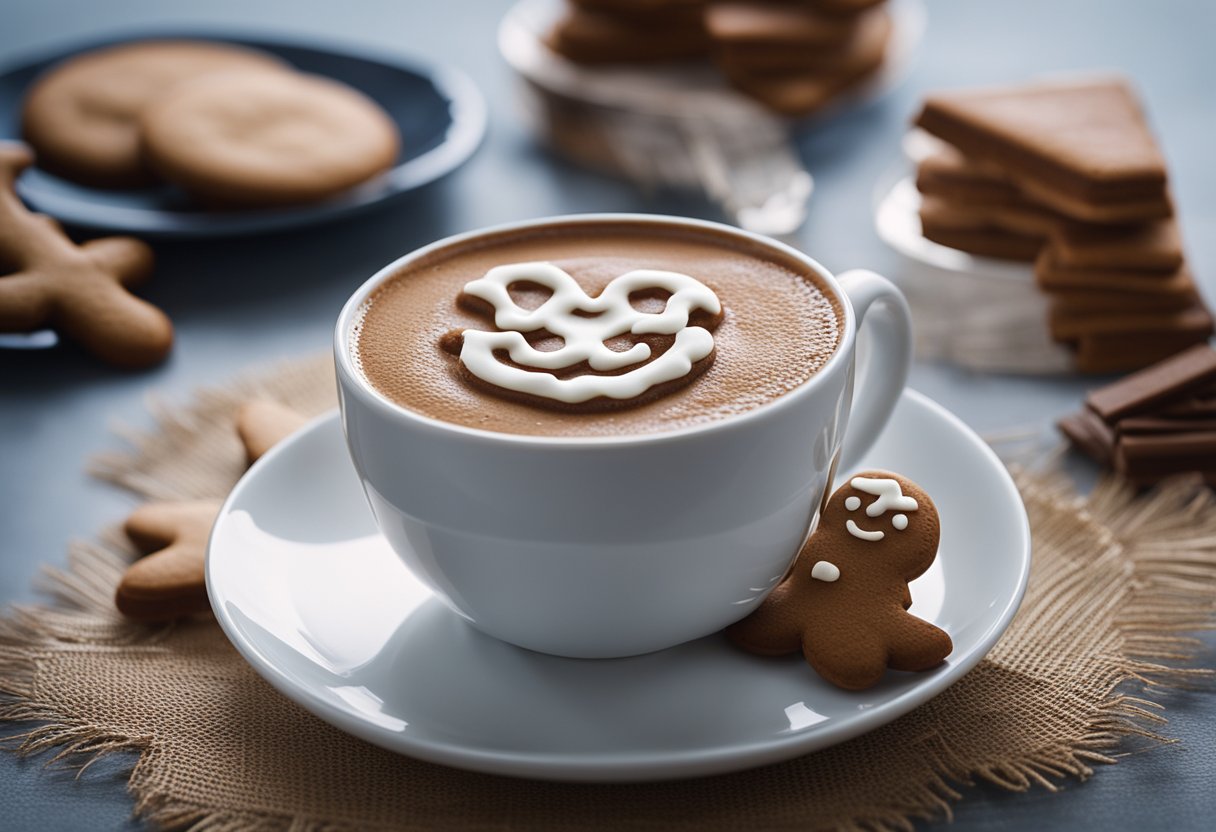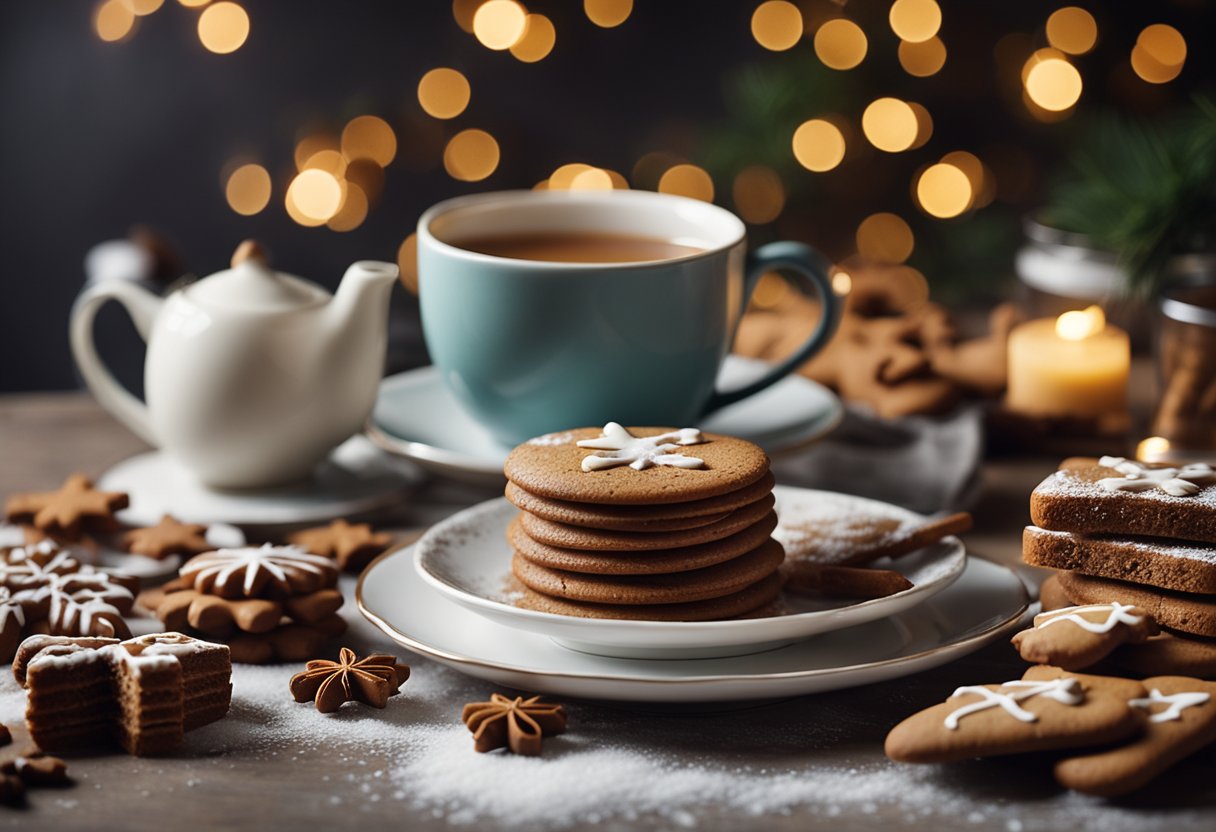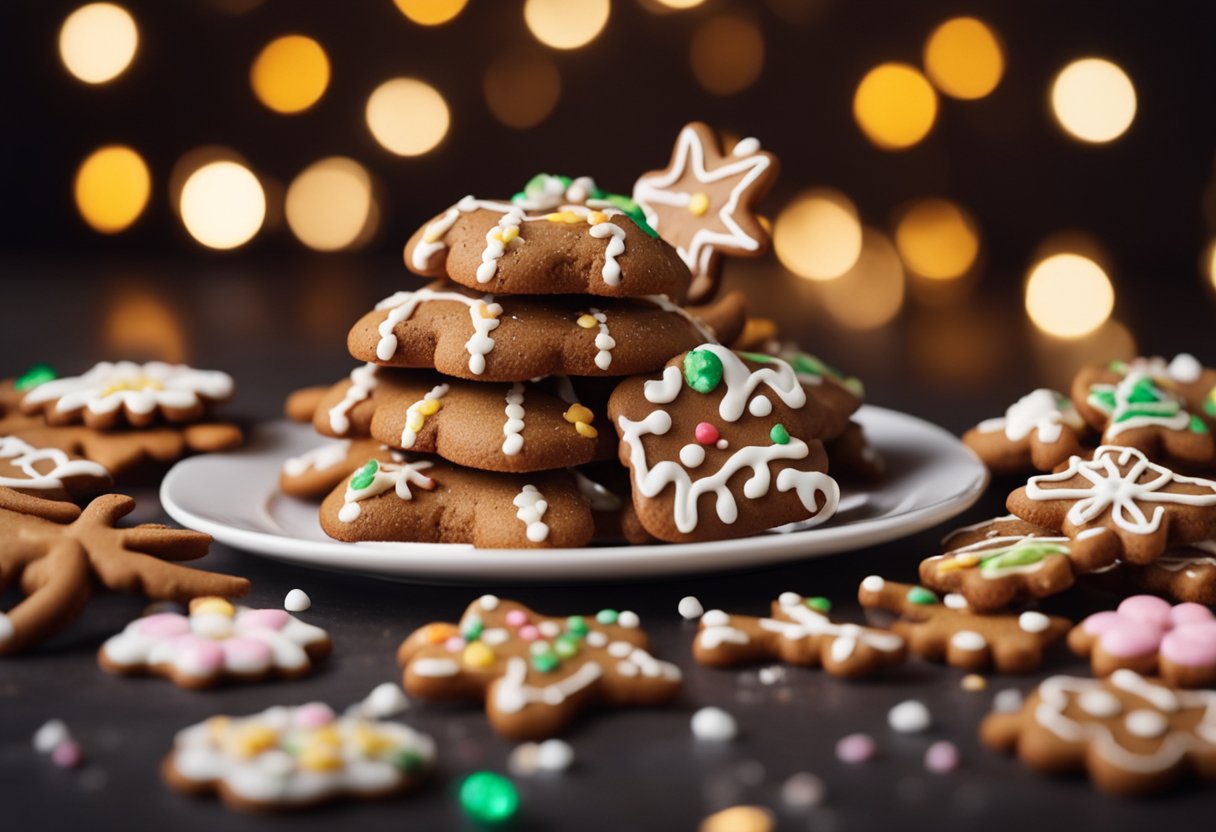Eating gingerbread is a delightful experience that is often tied to holiday traditions and the aromatic allure of spices. This indulgence is not just limited to taste but is also a sensory journey sparked by the distinct scent of ginger, cloves, nutmeg, and cinnamon. The warm, sweet, and spicy flavors encapsulate the essence of the festive season, making gingerbread a popular treat across various cultures during winter celebrations.

When enjoying gingerbread, it’s important to consider the texture as it can range from soft and cake-like to crisp and cookie-like. Whether you’re savoring a gingerbread man, house, or loaf, the method of eating may vary. Bite into the crisp edges of a gingerbread cookie to enjoy a satisfying snap, or slowly savor the moist, dense squares of a gingerbread cake to appreciate its rich flavor.
More than just a tasty snack, gingerbread often has a decorative aspect, especially in the form of gingerbread houses that combine culinary skill with creativity. While these edible structures are a feast for the eyes, they are also meant to be eaten. Break off a piece gently, taking care not to crumble the intricately adorned walls, and relish the balance of sweetness and spice. Remember to enjoy gingerbread in moderation, appreciating the craftsmanship and tradition that go into every piece.
The History and Significance of Gingerbread

Gingerbread has long stood as a symbol of festivity and tradition, weaving a rich tapestry through history, culture, and folklore. Your understanding of gingerbread will deepen as you explore its roots, cultural impact, and literary presence.
Origin and Evolution
Gingerbread’s journey began in Europe during the Middle Ages, evolving from a simple mixture of ginger and breadcrumbs to the sophisticated recipes we enjoy today. By the 16th century, it was a staple at gingerbread fairs in England, often shaped and decorated to resemble armor, animals, or religious symbols. Queen Elizabeth I is credited with the innovation of creating the first gingerbread men, fashioned to resemble foreign dignitaries and court guests.
Cultural Traditions and Variations
Across Europe, gingerbread takes on various forms, each steeped in tradition. In Germany, the Lebkuchen has been a Christmas delicacy for centuries, leading to the custom of baking gingerbread houses that we associate with holiday traditions today. Festive baking in Britain also saw the rise of the gingerbread man, while in America, the recipe was popularized in the late 18th century with the publishing of the cookbook “American Cookery”.
- Germany: Holds the tradition of crafting elaborate gingerbread houses, inspired by the folk tale Hansel and Gretel by the Brothers Grimm.
- Britain: Known for gingerbread men and ginger biscuits, a favorite at Christmas markets.
- America: Embraced gingerbread in the early American colonies, immortalizing it in cookbooks as an essential recipe.
Gingerbread in Literature and Popular Culture
Gingerbread has made notable appearances in literature and pop culture, epitomizing the notion of an edible treat laced with magical connotations. The tale of the Gingerbread Man, who outruns all his pursuers, has enchanted children for generations. The story of Hansel and Gretel introduced the gingerbread house as a central, albeit perilous, element. These stories have cemented gingerbread’s place in popular culture as a symbol of whimsy and nostalgia.
Ingredients and Preparation of Gingerbread

Before you begin crafting your gingerbread cookies, understanding the common ingredients and the roles they play is essential to achieving the perfect balance of flavors and textures. Equally important is mastering the preparation techniques, from dough making to baking.
Classic Ingredients and Their Roles
Gingerbread cookies owe their distinctive taste to a harmonious blend of spices and sweeteners. The consistency of the cookie depends on the proper balance of the following fundamental components:
| Ingredient | Role |
|---|---|
| Flour | Provides structure |
| Butter | Adds richness and tender crumb |
| Brown sugar | Contributes to flavor and moisture |
| Molasses | Imparts a deep, sweet flavor |
| Egg | Binds the ingredients |
| Ginger | Defines the classic spice |
| Cinnamon | Offers warmth to the flavor profile |
| Cloves | Adds depth to the spice mix |
| Nutmeg | Enhances overall spice complexity |
| Salt | Balances sweetness |
| Baking powder / Baking soda | Provides lift and affects texture |
Making Gingerbread Dough
When mixing gingerbread cookie dough, start by creaming butter and brown sugar together until light and fluffy. Next, incorporate the egg and molasses, ensuring these wet ingredients are well combined. In a separate bowl, whisk together the dry ingredients—flour, spices, and baking agents—before gradually integrating them into the wet mixture to form a cohesive dough.
- Cream butter and sugar
- Mix in egg and molasses
- Sift and combine dry ingredients
- Blend dry and wet ingredients to form dough
For ease of handling, wrap your gingerbread cookie dough in plastic and allow it to refrigerate for at least three hours.
Baking Techniques
Once your dough is chilled, preheat your oven to the recommended temperature, usually around 350°F. Then, on a lightly floured surface, roll out the dough with a rolling pin to an even thickness, about 1/4 inch.
- Preheat oven to 350°F.
- Roll dough to 1/4 inch thickness
Using cookie cutters, cut out your desired shapes and place on a baking sheet lined with parchment paper to prevent sticking. Bake the cookies for 8-10 minutes or until the edges are just beginning to brown. Allow the cookies to cool on the baking sheet for a few minutes before transferring them to a wire rack to cool completely.
- Cut out shapes and place on parchment paper
- Bake for 8-10 minutes
- Cool on baking sheet, then transfer to rack
Decorating and Enjoying Gingerbread

To truly appreciate gingerbread, both its taste and festive look, enhance it with eye-catching decorations before serving it alongside beverages that complement its rich flavors.
Creative Decorating Ideas
Your gingerbread canvas awaits a festive transformation. Utilize cookie cutters to shape your creations, then adorn them with royal icing. Start by outlining with white icing and fill in with thin ‘flood’ icing. For a pop of color and texture, apply candy pieces while the icing is still wet.
- Outline patterns
- Stars, trees, hearts
- Filling techniques
- Flooding, piping
Serving Suggestions
Present gingerbread as a standalone dessert or paired for heightened delight. Plate gingerbread cookies alongside ice cream or whipped cream to contrast textures. Smaller gingerbread pieces can top or garnish other desserts, adding a festive touch and a hint of spice.
- Alone or as a topping
- Accompanied with creams
Pairing with Beverages
Selecting the right beverage to sip with gingerbread can enhance your dessert experience. A warm mug of tea or coffee highlights the cookie’s spices. Alternatively, for an indulgent pairing, a small glass of rum can elevate the treat to a decadent delight.
- Warm beverages
- Tea, Coffee
- Spirits
- Rum
Health Benefits and Dietary Adaptations

Gingerbread isn’t just a festive treat; it also contains ingredients that can offer some health benefits. Understanding its nutritional properties and how it can be adapted to fit various dietary restrictions can help you enjoy this traditional food in a way that aligns with your health goals.
Nutritional Information and Health Benefits
Ginger, a key ingredient in gingerbread, is well regarded for its potential to aid digestion and reduce inflammation. When you consume gingerbread, you’re also getting a dose of the ginger’s active compound, gingerol. Molasses, another component, provides minerals like iron and calcium. Here’s a brief look at the nutritional value of a standard slice of gingerbread:
| Nutrient | Amount per Serving |
|---|---|
| Calories | 200-250 |
| Carbohydrates | 30-40g |
| Dietary Fiber | 0.5-1g |
| Sugars | 15-20g |
| Protein | 2-3g |
| Fat | 6-10g |
| Sodium | 300-500mg |
Remember that moderation is key, since gingerbread can be high in sugar and calories.
Gluten-Free and Vegan Options
If you’re gluten-free or vegan, you can still enjoy gingerbread by seeking out alternatives. For a gluten-free version, look for recipes or products that substitute wheat flour with almond, rice, or oat flour. For a vegan diet, ensure that the gingerbread doesn’t contain animal products such as eggs or dairy by checking the ingredients list or using substitutes like flaxseed meal or plant-based milks.
Storing Gingerbread for Freshness
To maintain the freshness of your gingerbread cookies, proper storage is essential. Keep them in an airtight container at room temperature for up to two weeks. If you need to store them longer, consider refrigeration or freezing. Wrap the cookies well and place them in the fridge, where they can last for up to a month, or in the freezer for up to three months. When you’re ready to enjoy them again, allow the gingerbread to reach room temperature to preserve its texture and flavor.
Frequently Asked Questions

Navigating the delicious world of gingerbread may raise questions about consumption and enjoyment. This section aims to address your most frequent inquiries with clear, straightforward answers.
What is the best way to enjoy gingerbread cookies?
Enjoy gingerbread cookies by pairing them with a glass of cold milk to complement the spices. These cookies are traditionally enjoyed warm to better appreciate their rich flavors.
What accompaniments go well with gingerbread cake?
Pair gingerbread cake with a dollop of whipped cream or vanilla ice cream to balance its robust, spiced flavor. The creaminess of these accompaniments contrasts nicely with the dense texture of the cake.
Can you consume a gingerbread house and how?
A gingerbread house made for consumption should be eaten within a couple of days of assembly. Break it apart into manageable pieces, ensuring any non-edible decorations are removed before enjoying.
Should traditional gingerbread have a soft or crunchy texture?
Traditional gingerbread can either be soft or crunchy, depending on personal preference. Soft gingerbread often has a chewy texture, while crunchy gingerbread is baked longer for a firmer bite.
What’s the reason for letting gingerbread sit before eating?
Letting gingerbread sit for a day or two before eating allows the flavors to meld and the texture to set, resulting in a richer taste experience.
How does adding molasses affect the way you eat gingerbread?
Adding molasses to gingerbread results in a deeper, caramelized flavor and a darker color. Its sticky texture can lead to a chewier gingerbread, so have napkins handy as it might get a little messy when eating.
